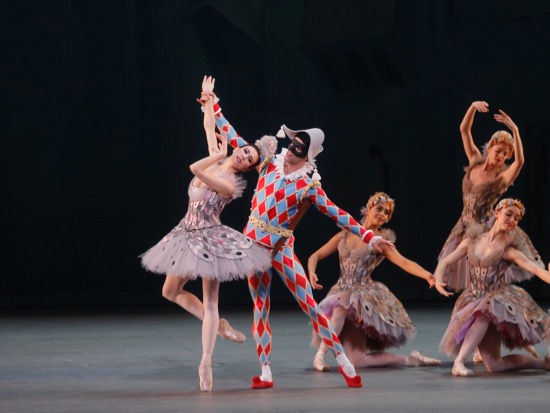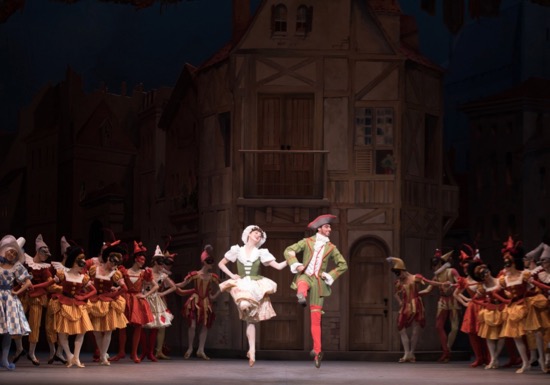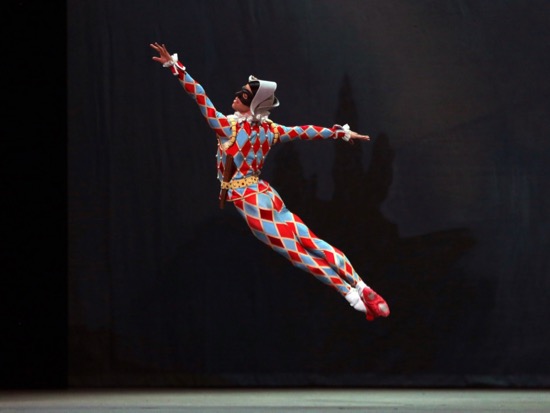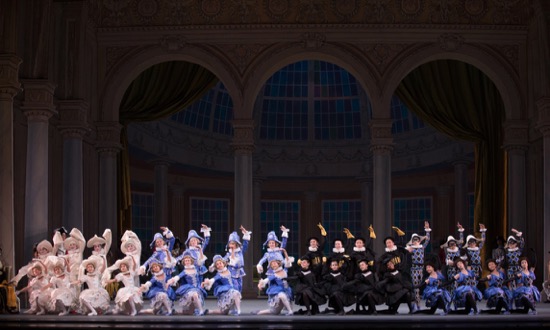American Ballet Theatre premieres Alexei Ratmansky’s remounting of Harlequinade.

Isabella Boylston (Columbine) and James Whiteside (Harlequin) attended by “larks”— one of the four casts in Alexei Ratmansky’s Harlequinade. Photo: Marty Sohl.
It’s almost two o’clock on a Wednesday afternoon, and I’m casing the audience that’s gradually filling the Metropolitan Opera House, where American Ballet Theatre is holding its spring season. Most of us, I’d guess, are either over 65 or under 12. More of us appear to be female than male. And, as Alexei Ratmansky’s creative revival of Harlequinade (1900) unfolds before our dazzled eyes, we are extremely well-behaved. We don’t even giggle or cry much when Harlequin is thrown off a balcony and is then hastily dismembered and hidden (that’s partly because anyone can see that he’s a stuffed dummy and not dancer Danil Simkin, this afternoon’s Harlequin).
George Balanchine performed in Marius Petipa’s Les Millions d’Harlequin, when he was a child dancer in St, Petersburg’s Imperial Ballet. Based on his memories and Riccardo Drigo’s music, he created his own version for New York City Ballet in 1965. Ratmansky, on the other hand, is addicted to digging back to the roots of ballets that interest him (may he never lose that yen). His Harlequinade is based on an early 20th-century manuscript in Harvard’s Houghton Library that records many of Petipa’s steps and formations in the notation system devised by Vladimir Ivanovich Stepanov (1866 – 1896). Ratmansky filled in the blanks expertly, consulting other versions and fleshing out scanty descriptions.

Courtney Shealy and Luis Ribagorda lead the variously costumed crowd in Alexei Ratmansky’s Harlequinade. Photo: Rosalie O’Connor.
The story got its start in the 16th-century antics of Italian and French commedia dell’arte troupes. In this ballet’s particular scenario, Pierrot is the servant of Cassandre, and his wife Pierrette takes care of Cassandre’s daughter, Columbine. She loves Harlequin, but her father wants her to marry the fussy (and rich) Léandre. Stuff happens. All ends well. In the ballet, these characters, with their gambits, and chicaneries, are surrounded not just by drunken gendarmes, soldiers, lackeys, attendants, friends, henchmen, and partying aristocrats, but by people who can’t miss an opportunity to dance. So we encounter a masked ensemble costumed as Spanish dancers, peasants, commedia characters; escapees from a pack of cards; thirty-two children who dance, in differently attired groups of eight—as Commedia characters; and a dozen women in gray tutus, identified as “larks” who tend to arrive in pairs and swarm into orderly formations, and who bedeck Harlequin and Columbine’s Act II duet, in which he depicts a hunter and she the loveliest of the birds.
The splendid costumes (plus wigs, dominos, and headdresses) by Robert Perdziola—over 250 of them—were inspired by the 1900 designs by Orest Allegri and Ivan Vsevolozhsky (the latter the director of the Imperial Theatres). Perdziola also designed Harlequinade’s sets. Act I takes place in a village square with one prominent house. Along the forking “streets,” people race and skulk and parade. When a fortunately acquired magic wand is waved, the house’s entire balcony descends as smoothly as an elevator, delivering Columbine (Skylar Brandt in the cast I saw) to her nimble Harlequin. Act II is set in a column-edged ballroom with great glass windows, perhaps the interior of Cassandre’s dwelling.
Unlike many choreographers reviving classics, Ratmansky is not afraid to include the mime gestures that clarify the story. “She is beautiful,” “I want to marry her,” “Let me think,” “I love him,” “he is sleeping,” “I’m hungry,” “I/he/she is angry.” “No way!” I’m fond of one gesture that appears several times; it seems to mean, “who knows?” or “what can I do about it?” Roman Zhurbin, in a fine and nuanced performance as Cassandre, introduces the ballet with a mime sequence directed right at us and at the musicians in the pit. The dancers deliver their gestures with gusto, and Drigo’s music supports various dramatic effects, in addition accompanying happy dancing.

James Whiteside as Harlequin in one of the casts performing American Ballet Theatre’s Harlequinade. Photo: Marty Sohl.
Ratmansky is adept at creating the kind of natural behavior that reveals relationships and plot points. Watchers on the sidelines remain animated. During a pas de quatre for Columbine, Harlequin, Pierrette (Hee Seo), and an obliging friend of Harlequin’s (Blaine Hoven), the two women exchange glances or smile at each other in passing. When Pierrette does a solo, Pierrot (Alexandre Hammoudi) sits and watches her admiringly. The already drunken soldiers, a posse of six, sent by Cassandre to find his escaped daughter, wave lanterns around in their fruitless attempts to track her. When commanded by their leader (Marshall Whiteley) to march away in formation, they manage—barely; the most incapacitated fellow has an especially hard time keeping up. Léandre’s two lackeys (Connor Holloway and Tyler Maloney) let us know just how weary they are of assisting this perfumed fop (Duncan Lyle); they can hardly contain their laughter when he shows off by playing a lute while dancing and opening his mouth in silent song.
As you’d expect in a vintage ballet like this, the formations are orderly and symmetrical. If eight performers are going to dance in unison, each knows his/her place onstage and tends to stay there. Prancing figures may make a line coil or uncoil, or break away from a big circle to form smaller ones. Pirouettes and tricky footwork contrast to all manner of springy steps. Blocked pointe shoes were only about thirty years old in 1900, and sustained pointework is featured, especially in Columbine’s solos, one of which keeps Brandt on her toes for a considerable amount of time. The movement vocabulary is surprising as well as expected. Brandt whipped one leg around the other in descending from a turn in a way I can’t recall seeing before, and she inserted little flickers of one foot into a usually undecorated passage. Simkin, who has terrific elevation, kept his legs glued together as he vaulted into the air on a slant, seeming suspended there for a second, before he had to separate one leg and prepare to land.
Drigo’s score emphasizes elements of drama. Via a revolving platform, a statue is replaced by a Good Fairy (Tatiana Ratmansky), who gives Harlequin what looks like a magic wand. Actually it’s a slim, slit “slap-stick,” and its smart crack when wielded has a musical equivalent. Other peremptory moves are similarly amplified by music, but, of course, the bulk of the score is sweetly tuneful.

The children echoing commedia dell’arte characters in Harlequinade. Photo: Rosalie O’Connor.
In Act II, the children (all students in the Jacqueline Kennedy Onassis School at American Ballet Theatre) have a dance of their own, four male-female couples at a time. They’re costumed as miniature commedia characters. The males in the first dance have the big bellies of a Pantalone. The Harlequins wave slap-sticks. The Pierrots have overly long white sleeves and the dejected walk of their model. The eight in black may represent Il Dottore, although they’re good at miming “she’s beautiful.” Each successive squad of eight dances, not just in unison, but as partners, each with his/her own steps and behavior. The young dancers charmed us with their diligence and vivacity.
I was especially delighted by Seo’s saucy clarity as Pierrette, but every principal dancer in the cast I saw presented a nicely fleshed-out character, as well as performing the steps with élan. In fact, everyone on stage seemed as lively as the ballet required. A rollicking farce stuffed to bursting with wonderful dancing. . . .what more could you want on a spring afternoon? Or, for that matter, on a spring evening?

“Ratmansky is adept at creating the kind of natural behavior that reveals relationships and plot points.”
I wonder what he learned about that during his time with the Royal Danish Ballet.
I appreciate Sandi Kurtz’s bringing up what I have noticed about Ratmansky’s works, but failed to mention this time. Yes, I too feel that the time he spent in Denmark performing in ballets by the great 19th-century choreographer August Bournonville may have influenced his ways of showing a believable society onstage.
Nice post and very important information about ballet dancing. It had covered almost every information . That’s impressive.